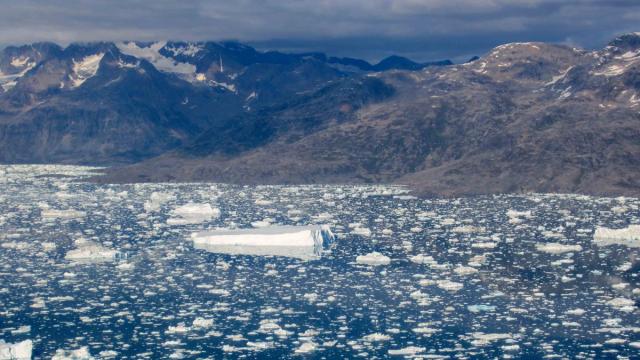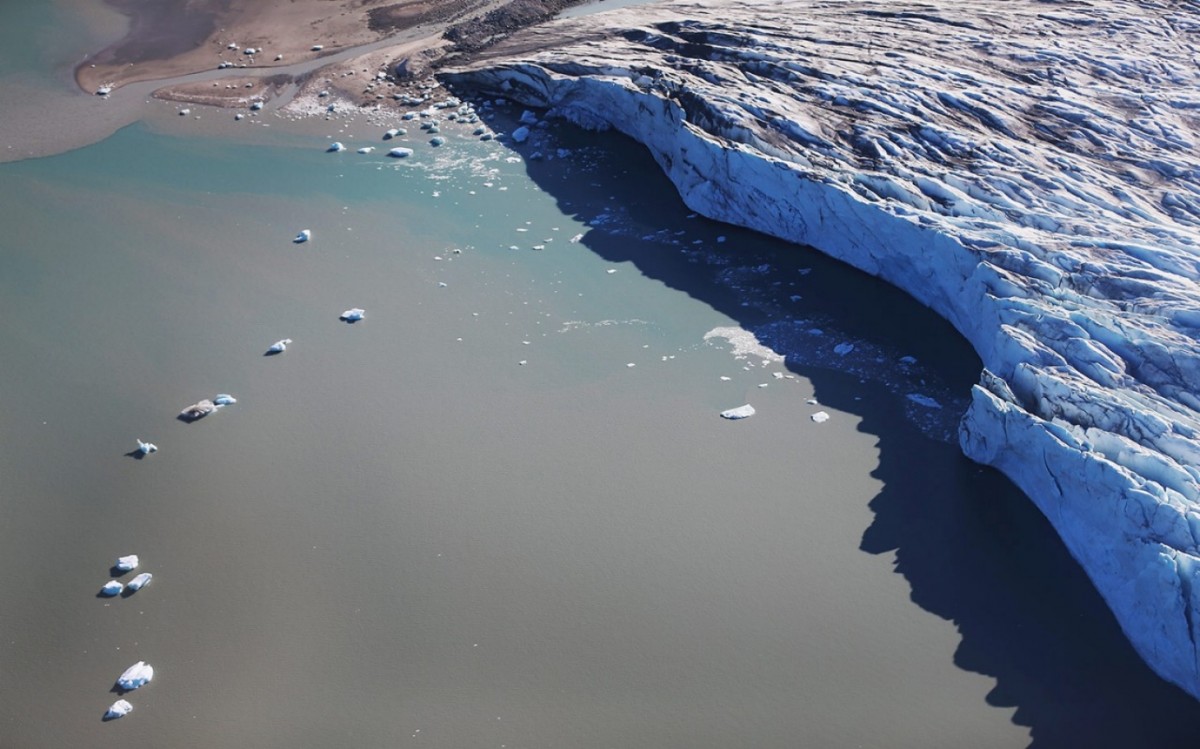
This article is the second in an ongoing series about the sweeping changes occurring in Greenland due to climate disruption. Read the first article here
Climate change has Greenland in its grip like no other nation. And the relationship between the planet as a whole, and a single country, is unique in the annals of civilization’s history. Yet despite its size and the catastrophic relationship to other nations’ futures – they will sink for Greenland to rise – Greenland only lurks on the fringe of modern consciousness.
On older, Mercator-projection maps, it looks gigantic, a white whale of a place, a tinted fringe demarcating the coast not beneath ice. Newer maps show it as 20 percent ice free. There are no maps yet available contrasting the good fortunes of Greenland to those of its less fortunate southern cousins, small island nations like the Maldives and Tuvalu.
How all the climate savagery will play out is uncertain. As Greenland sheds its ice, though, America’s east coast is shedding insurability for individuals for flooding, Bolivia is losing villages because glacier melt no longer insures crop survival, and the Maldives are losing everything, their atoll going under.
Below are brief looks at three places – two productive cities by the sea and a high-altitude plateau in the Andes – feeling the impacts of change. The complex synergy of warming temperatures, glacier melt, thermal expansion of seas, land masses sinking and rising, make accurate predictions impossible. And uncertainties, unfortunately, make it impossible to say how fast things will go. Funding cuts for climate research in America, promised by the Trump administration, will dampen evidence-based research. And other nations, given America’s recalcitrance and denial of science, may follow.
Three Places of Change
"It’s not that he’s vacuous, that’s a mistake. He has some consistent commitments. One of them, and probably the most dangerous, is to end the efforts to try to deal with the most significant problem we face, how to confront the very urgent and serious problem of environmental catastrophe. We don’t have a long time to deal with that." - Noam Chomsky on Trump, Medium, January 11, 2017
Bolivia’s Altiplano
Chacaltaya, a glacier overlooking La Paz, Bolivia’s largest city, was the world’s highest ski area until 2005. It has melted. Like Greenland, Bolivia’s indigenous peoples are confronting climate change now. Alas, as Greenland wrestles with the prospect of prosperity, Bolivia is unlikely to make the year 2100.
The Uru-Murato, Bolivia’s oldest tribe, abandoned the shrinking, fetid shores of Lake Poopó in 2015. Lake Poopó died from drawdowns of feeder streams to irrigate quinoa, a grain prized by health advocates in the U.S. and elsewhere; sediment from nearby gold mining operations smothering the lake’s bottom; and toxins that made fish spin in circles while the flocks of flamingoes left. When nets were hauled up empty, even of sick fish, “it was enough to make you cry,” said a former fisherman. And enough to move the Uru-Murato elsewhere.
One alternative was El Alto. A satellite of La Paz, but higher on the Altiplano, El Alto has been drawing refugees from Bolivia’s climate craziness – draughts, floods, mud slides, frosts – for decades. Natives move to urban centers to survive. But El Alto is now beset by water shortages, overcrowding and corruption. Like Chacaltaya and Lake Poopó the young city depended on an ancient source, the natural reservoirs of the Andes, not only for water but also to power the production of electricity, a necessity in the modern age.
"We have a big problem and even money won't completely solve it," said Pablo Solón Romero back in 2009. "What do you do, when your glacier disappears?" But even as Bolivia’s ambassador to the U.N. and an activist for human water rights, Solón's warnings mostly fell on tin ears, especially in the mining industry.
One argument, that money and engineering could sustain El Alto, La Paz and the Altiplano, did not hold water. Comparing the low-maintenance reservoirs of nature, which glaciers had been for millennia, with a substitute, even one well-designed by engineers, revealed troubling realities. Foremost, to act, Bolivia had to plan, then spend, and finally manage change of a magnitude seemingly beyond a poor, colorful and politically volatile nation. Government, rather than doing more, did less. Warmer climate, weak government and a poorly regulated mining industry were not a winning combination of forces. Response to climate change never materialized. Meanwhile, glaciologists constantly stated the obvious: the retreat of the Andes glaciers was outpacing the wildest expectations.
Case in point: in January of this year, Bolivian President Evo Morales declared a national emergency after the worst draught in 25 years. Meanwhile, Bolivia and Chile were fighting each other over water in the Hague, at the International Court of Justice. Dams were dry, with trucks hauling water to El Alto and elsewhere, and some mines still getting their normal flows despite cries of mismanagement.
In other words, on Bolivia’s spectacular Altiplano, and in its kiss-the-sky villages, amidst its strong and determined people, the status quo ruled. Political infighting continued as the nation went dry.
Mumbai: Megalopolis of Dreams
Until the late 18th century, the city called Bom Bhaia by the Portuguese, then Bombay by the British, was seven islands in a vast bay separated by swamps and tides. Today it is Mumbai, India's financial center and largest city, a man-made and engineered metropolis jutting out into the Arabian Sea on a shaky substrate.
Originally, the substrate was stone toppled off rafts by prison convicts. A successful engineered embankment eventually anchored the first causeway between islands. By the mid-1800s the islands were elevated bumps in an ongoing land reclamation project that aped Holland’s success in holding back the sea. Breakwaters protected the new inhabitable land. By the 20th century Bombay had a curving seafront promenade, called the Queen's Necklace because of its illumination and appeal. World-class architects and big money gradually built a modern, cosmopolitan city.
That is, a glittering city on less than firm footings. India’s poor had also flocked to Bombay, drawn by its power and isolated in slums often described as “unfit for human habitation.” This imbalanced metropolis of squalor, glitter, promise and wealth is the Mumbai of today.
But now there’s global warming and rising seas establishing new hurdles of continuous restoration in a city populated by over 18 million people. The city of dreams now faces the nightmare of a short life span. High tides regularly flood the slums, overrun embankments and turn the causeways into water parks for children of the displaced. An excellent history piece about Mumbai, written by Srinath Perur for The Guardian, declares in its final paragraph: “It's almost as if Mumbai doesn't remember where it came from."
Where it came from may well be where Mumbai returns: to the sea.
No city in India is more endangered. When global temperature goes up 2 degrees Celsius (3.8 F), the so-called magic climate change number, folks will pine for the former hills. An estimated 5.8 million of them will have lost their homes.
What are the odds that Mumbai will be swamped before 2100? Will Greenland willingly take in a million of the displaced? Will the Inuit leadership of a vast land mass three times the size of Texas, if the Inuit retain power, have sympathy for the Indians? Will Greenland then have international obligations to take in environmental refugees, having been one of the identifiable causes of their desperate condition? That’s an uncertainty no nation or international body is yet even capable of considering, never mind affecting.
Boston’s Back Bay
In 1630, when the Puritans still got along with the Native Americans, Boston consisted of 783 acres: three hills overlooking a scraggly peninsula. By 1990, land reclamation projects had narrowed the rivers, filled in the wetlands and made Boston 4,000 acres large. Back Bay, which remains the symbolic and physical heart of Boston, had appeared in the 1800s. It retains a splendid architectural mix from Trinity Church, an Episcopalian brownstone showplace designed by HH Richardson, to the Hancock Tower, a 60-story glass-sheathed skyscraper, viewed two-dimensional from certain angles, which had to be anchored by steel pillars pounded into bedrock far below so the structure didn’t fall over in high winds.
In 2017, symbolic or not, Back Bay and much of downtown Boston is highly vulnerable to rising seas and storm surges. To date, engineering has saved Boston with seawalls, dykes and dams. But in the new millennium, like most U.S. cities on ocean shores, Boston has failed to prepare for impacts, from Greenland glacier flow or elsewhere.
“A lot of talking, a lot of thinking, a lot of postponing” has been the norm, said Jerold S. Kayden, project director of the Harvard-Netherlands Project, speaking a few years ago. Kayden’s project intended to explore the range of possible options, as Corydon Ireland wrote in “Rising Seas, Imperiled Cities,” so that Boston’s environmental defenses got much-needed updating.
It hasn’t happened. Political barriers, high costs and uncertainly stalled action. A nasty trifecta – bad storm, high tide, full moon – “would make most of Boston briefly part of the Atlantic Ocean,” Ireland noted, putting Back Bay and city landmarks like Faneuil Hall partially under water. Should Boston get hit by a mammoth surge, winds and a once-in-a-hundred-year storm, the results “would temporarily reduce Boston, including Bunker Hill, to a series of drumlins,” Ireland warned, falling back on the Irish word to describe elongated ridges shaped by the ice age and aimed in the direction of the ice flow.
In other words, return Boston to how it looked long before the Puritans showed up waving the Bible and soon routing the natives.
Greenland’s Role in All This?
As noted at the start of this column, uncertainty is the only certain truth about climate change, even based on evidence-based science. Greenland isn’t going to reverse what our carbon burning world has set in motion. Nor should it be blamed for the impact its nakedness will bring to the collective future.
It would be nice, however, to set a plastic duck on top of Greenland’s ice cap this coming summer, let it ride down a moulin, a long shaft through the melting ice, pop out into the North Atlantic and show up in Boston Harbor, just to remind planners that the two places are intimately connected. Add the Floating Duck to the Butterfly Effect, if you will.
Stay tuned for the next Greenland Naked column looking at how most of the global media packages Greenland as a curious side show rather than a key to Earth’s future. Follow Joe Sherman on Facebook @theclimatehack.
3 WAYS TO SHOW YOUR SUPPORT
- Log in to post comments














